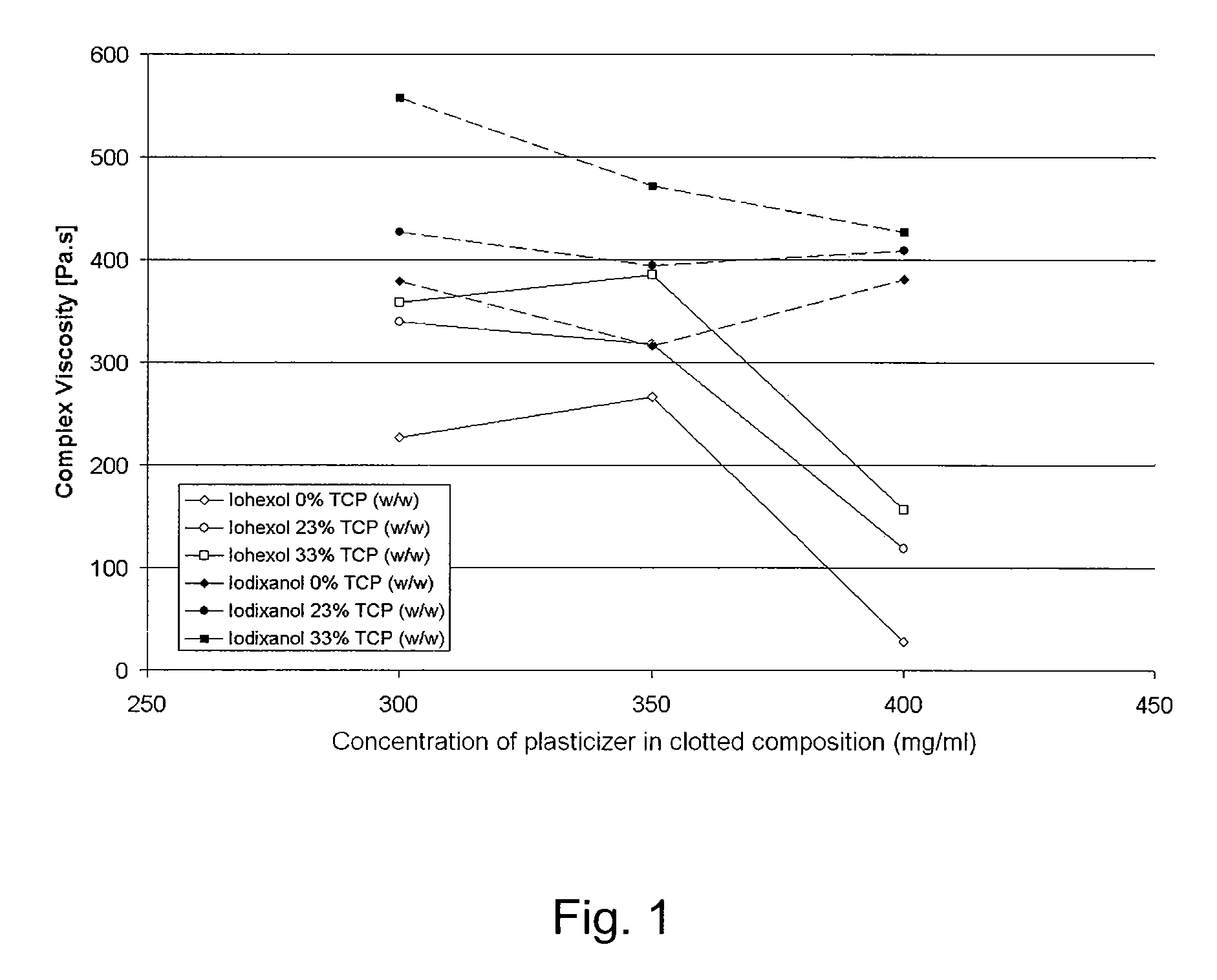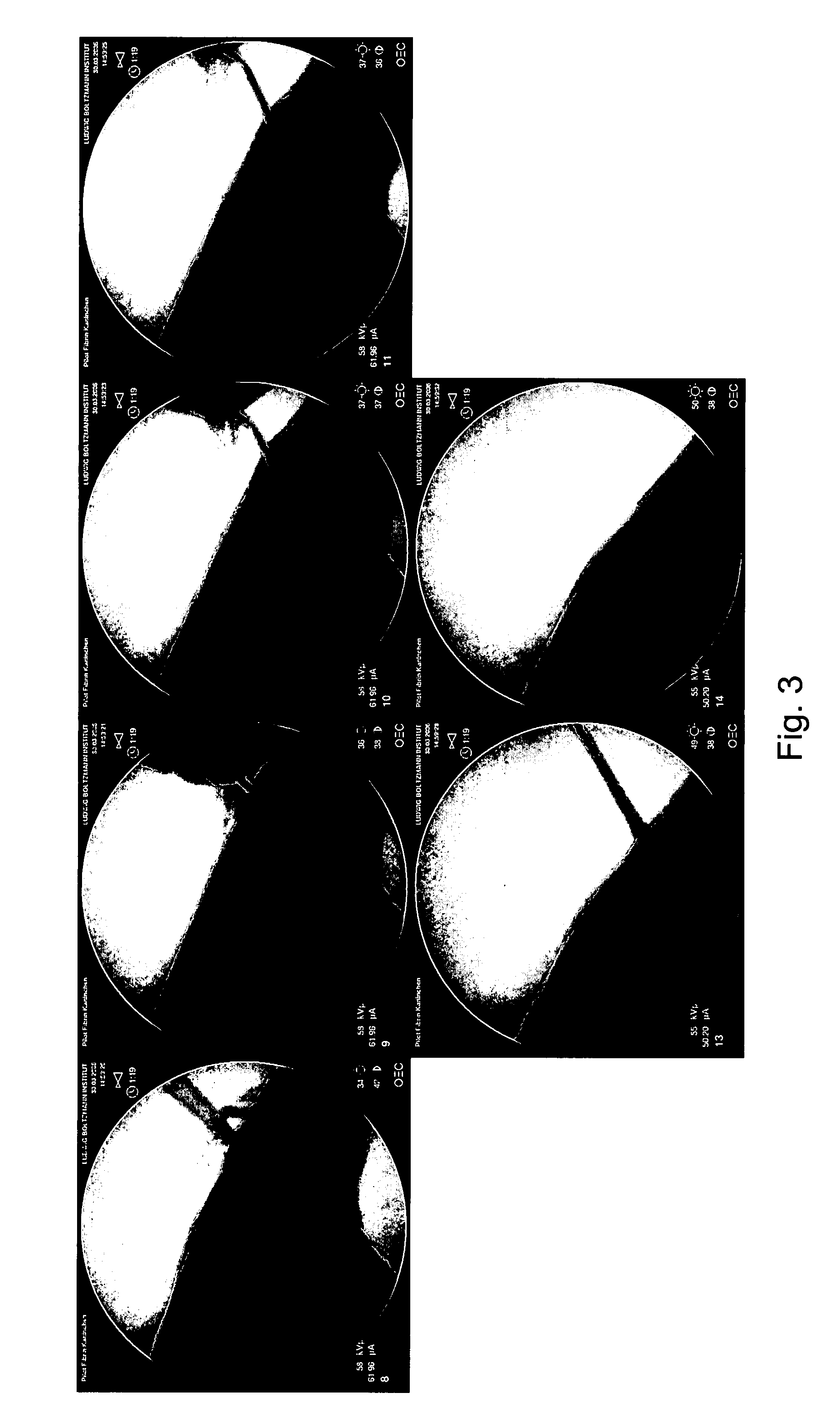Injectable bone void filler
a technology of fibrin and filler, which is applied in the direction of tissue regeneration, pharmaceutical delivery mechanism, prosthesis, etc., can solve the problems of auto- and allograft loss of biological and mechanical properties, trauma, infection and morbidity, etc., and achieve the effect of superior to fibrin
- Summary
- Abstract
- Description
- Claims
- Application Information
AI Technical Summary
Benefits of technology
Problems solved by technology
Method used
Image
Examples
example 1
Preparation of Bone Void Filler Composition Containing Fibrin, Glycerol and Calcium Phosphate
[0067] Materials:
FibrinFreeze dried fibrinogen powder reconstituted withsealantaprotinin solution to a total clottable protein concentrationsolutionof 91 mg / ml.Iodixanol5-[acetyl-[3-[acetyl-[3,5-bis(2,3-dihydroxypropylcarbamoyl)-2,4,6-triiodo-phenyl]-amino]-2-hydroxy-propyl]-amino]-N,N′-bis(2,3-dihydroxypropyl)-2,4,6-triiodo-benzene-1,3-dicarboxamideIohexol5-(acetyl-(2,3-dihydroxypropyl)amino)-N,N′-bis(2,3-dihydroxypropyl)-2,4,6-triiodo-benzene-1,3-dicarboxamideParticlesTricalcium phosphate particles (TCP), 35 μm, spherical(Plasma Biotal, Derby UK)ThrombinFreeze dried thrombin powder reconstituted with 5 ml of500 IU / mlthrombin buffer, to a concentration of 500 IU / ml.Thrombin40 mM CaCl2 in H2OBuffer
[0068] A 40% plasticizer (gycerol) and 10 IU / ml thrombin solution is prepared in a thrombin dilution buffer (40 mM CaCl2 in double distilled water). The solution is then homogenised. The solutio...
example 2
Preparation of Bone Void Filler Composition Containing Fibrin, a Contrast Agent and Calcium Phosphate
[0072] Either an 80% or a 60% plasticizer (contrast agents iodixanol or iohexol) and a 75 IU / ml thrombin solution is prepared in a thrombin dilution buffer (40 mM CaCl2 in double distilled water) The solution is then homogenised. The solution is centrifuged to remove bubbles and sterilised by filtering through a 0.22 μm filter. The fibrinogen is mixed with thrombin / contrast agent (CA) in a 1:1 ratio (therefore the plasticizer concentration in the gelled clot is halved to either 40 or 30%). For this 2 ml of the thrombin / contrast agent solution is transferred to a 5 ml syringe. 2 ml of fibrinogen (91 mg / ml) is transferred to a separate 5 ml syringe. The particles (ca. 2 μm) are incorporated as percentage weight of the final clot volume (w / v). These are weighed and placed into another 5 ml syringe.
[0073] The syringes containing the particles and the thrombin are connected via a Luer a...
example 3
Use of the Bone Void Filler for Filling a Bone Void in the Long Bone of a Rabbit
[0077] The injectable bone void filler was prepared according to Example 2.
[0078] The bone marrow is removed from a rabbit long bone to form a hollow bone. Then the injectable bone void filler is injected into the hollow bone using a plastic catheter. After the procedure, the plastic catheter is easily removed from the hollow portion of said bone (cf. FIG. 3).
PUM
| Property | Measurement | Unit |
|---|---|---|
| diameter | aaaaa | aaaaa |
| diameter | aaaaa | aaaaa |
| diameter | aaaaa | aaaaa |
Abstract
Description
Claims
Application Information
 Login to View More
Login to View More - R&D
- Intellectual Property
- Life Sciences
- Materials
- Tech Scout
- Unparalleled Data Quality
- Higher Quality Content
- 60% Fewer Hallucinations
Browse by: Latest US Patents, China's latest patents, Technical Efficacy Thesaurus, Application Domain, Technology Topic, Popular Technical Reports.
© 2025 PatSnap. All rights reserved.Legal|Privacy policy|Modern Slavery Act Transparency Statement|Sitemap|About US| Contact US: help@patsnap.com



